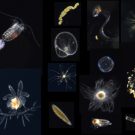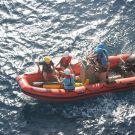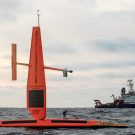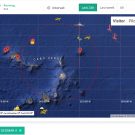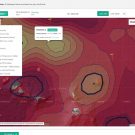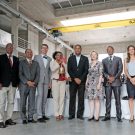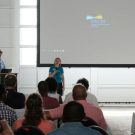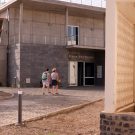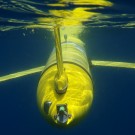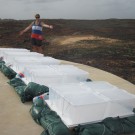(English below) Es schneit, es schneit, …. Auf den Kap Verden?! Nein, nicht das, was ihr denkt! Die Rede ist von “marine snow”. Also Schnee im Ozean. Das sind herabsinkende Partikel oder Aggregate biogenen Ursprungs, die unter Wasser wie Schneeflocken aussehen und eine wichtige Rolle im Partikelfluss des Ozeans spielen. Diese Aggregate, beispielsweise aus abgestorbenem […]
#MOSESEDDYHUNT: Einblick in die Wassersäule / Looking into the water column
(English below) Seit 14 Tagen sind wir nun schon an Bord des Forschungsschiffs FS METEOR. Unser Ziel ist es, die Wechselwirkungen im Meer rund um die Kap Verden herum zu untersuchen. Dafür haben wir schon eine ganze Reihe von Instrumenten eingesetzt, mit denen wir die Meeresoberfläche und die Wassersäule vermessen und beobachten. Die HZG-Wissenschaftler an […]
#MOSESeddyhunt: Segelnde Messroboter gesichtet / Sailing measuring robots sighted
(English below) In meinem ersten Beitrag zur gerade stattfindenen Wirbeljagd im tropischen Atlantik habe ich von mehreren autonomen Geräten gesprochen, die schon vor der Schiffskampagne vor den Kapverdischen Inseln im Einsatz waren, um die anrückenden Wirbel einer Voruntersuchung zu unterziehen. Zwei dieser Geräte möchte ich heute genauer vorstellen. Sie zeigen noch einmal deutlich, wie groß […]
Die #MOSESeddyhunt hat begonnen / The #MOSESeddyhunt has begun
(English below) Am 23.11. sind wir planmäßig aus Mindelo ausgelaufen. Die ersten Tage auf See waren sehr arbeitsintensiv. Alle Geräte an Bord mussten vorbereitet werden und die Routine an Bord musste sich einspielen. Währenddessen werten Kollegen in Kiel und am HZG Satellitenbilder aus der Region aus und erstellen Computersimulationen der Wirbelbewegungen. Zusammen mit den Echtzeitdaten […]
Auf der Jagd nach den Wirbeln – Die #MOSESeddyhunt startet / The #MOSESeddyhunt starts
(English version below) Langsam wird es spannend. Forscherinnen und Forscher aus Kiel, Geesthacht, Kaiserslautern, Bremen, Aachen sowie von den kapverdischen Inseln legen derzeit im tropischen Nordostatlantik ihre Daten-Netze aus. Netze, in denen sie einen Eddy fangen wollen. Am besten sogar mehrere. Eddy? Wer – oder was – ist das eigentlich? Also, bevor wir die Jagd […]
It’s official: the OSCM is fully operational!
The second day of the International Workshop on Marine & Atmospheric Science in West Africa had a more official focus. Today, representatives of the Republic of Cape Verde, among them Carlos Évora Rocha (National Director of Maritime Economy of the Republic of Cabo Verde), Dr. Osvaldina Silva (president of the INDP) and Augusto Neves (mayor […]
The importance of time-series observations
The first day of the International Workshop on Marine & Atmospheric Sciences in West Africa saw some very interesting talks on different observatories and long-term measurements in the Atlantic, scientific results gained from these observations and future research ideas. In the morning the focus was on the ocean itself, in the afternoon we moved on […]
International Workshop on Marine & Atmospheric Sciences in West Africa starts today
For this moment we’ve been working very hard. Today starts the first major international workshop at the brand new Ocean Science Centre Mindelo with a traditional icebreaker event. More about the International Workshop on Marine & Atmospheric Sciences in West Africa and the OSCM inauguration ceremony on Tuesday soon here in the blog. All participants […]
Glider survey started…
Right after New Year’s Day a team of GEOMAR and INDP scientists and technicians have successfully deployed a pair of two oceanographic SLOCUM gliders. The two gliders were prepared on land at INDP and later deployed from RV Islandia south of the island of Santo Antao. The two gliders are equipped with a suite of […]
Collecting Saharan dust at Cape Verde
„Why the hell do you go to Cape Verde to collect Saharan dust??“ was the question that Mirja was confronted with several times by the locals at Cape Verde in October. Of course it would be much easier to collect the sand straight from the Sahara desert in one day instead of mounting boxes on […]
